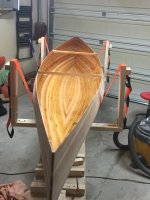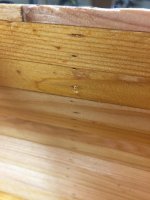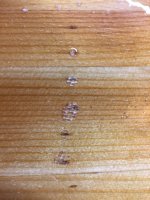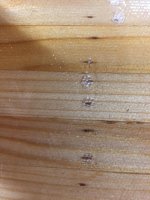So just finished laying up the inside football on my cedar strip canoe - main inside layer yet to come. It's my first build, and I filled the staple holes in the outside before glassing, as (despite everything I read) I thought I could camouflage them a bit. While I now have sort of beige staple hole marks instead of resin colored ones, the difference is pretty marginal so I decided I would not bother filling them when I did the inside. Seems that was a mistake, as I got lots of outgassing around many of the staple holes on the inside (I assumed that since they were already filled under the exterior coat I would be covered for this, but apparently not), leaving a bunch of small bubbles under the glass here and there. Squeegeed most of them out before everything set up, but still quite a few left.
I just did a base coat over the rest of the inside to head off more bubbles when I lay the full inside glass, so I think I will be covered there. But is there anything I can do to get rid of them under the football glass before I put on the main layer? There are maybe 20-30 scattered around the hull - none are very big, and the football overall is solidly glassed. I can live with them but if there's is a quick fix before I go any further with the glass (eg some "surgical" sanding that won't be obvious once the next fibreglass layer is on) I would appreciate anyone's thoughts/experience in this.
Thanks all
I just did a base coat over the rest of the inside to head off more bubbles when I lay the full inside glass, so I think I will be covered there. But is there anything I can do to get rid of them under the football glass before I put on the main layer? There are maybe 20-30 scattered around the hull - none are very big, and the football overall is solidly glassed. I can live with them but if there's is a quick fix before I go any further with the glass (eg some "surgical" sanding that won't be obvious once the next fibreglass layer is on) I would appreciate anyone's thoughts/experience in this.
Thanks all




